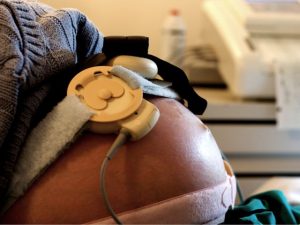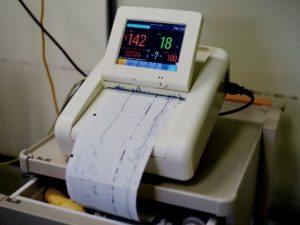Amniotic Fluid Embolism: Preparing for a Rare Obstetrical Emergency
- Amniotic fluid embolism (AFE) is an extremely rare obstertrical event. So rare that even many labor and delivery providers haven’t even witnessed it.
- AFE is a complicated issue. It cannot be predicted or diagnosed by tests or labs. It can only be identified by clinical presentation or autopsy. Mortality is of high risk for the mother, and moderate to low for the baby.
- While one may never witness this in a clinical setting, it is important to be aware of an AFE, so you can be proactive. Your own knowledge alone can be the reason a mother and babys’ lives are saved.

Renae Black
RN, BSN, CNM. CDR, USN retired
Amniotic Fluid Embolism, or AFE, is a rare but often times a fatal obstetrical event.
It is not diagnosed by any specific tests or labs, but by clinical presentation or autopsy if the mother does not survive.
Treatment is with supportive care with a multidisciplinary approach that is known to frequently deplete hospital resources due to the personnel and material resources needed.
What is Amniotic Fluid Embolism?
An AFE is a catastrophic event in pregnancy that presents with acute cardiopulmonary collapse and disseminated intravascular coagulopathy (DIC). The hallmark signs of AFE are hypoxemia, hypotension and coagulopathy.
AFE is unpreventable and unpredictable. There is no specific diagnostic criteria or labs to identify AFE. Diagnosis is based on clinical presentation and autopsy. Treatment begins with basic life support (BLS) and calling for assistance as the resuscitation efforts are intense. It requires a solid multidisciplinary approach with a plethora of resources.
The theory is that AFE occurs when amniotic fluid, fetal cells, vernix, meconium, hair and debris gets into the maternal circulation. Amniotic fluid embolism was first documented by autopsy in the 1920s when fetal epithelial cells were found in the maternal pulmonary vasculature after sudden death. The body responds with a complex systemic pro-inflammatory reaction which results in cardiopulmonary arrest and DIC.
The incidence of AFE is 1 in 12 patients per 100,000 women. Older studies show the maternal mortality rates may be as high as 80%. However, more recent studies show the maternal mortality rate of AFE is 13-26%, and fetal mortality rate is 10%.
It is hypothesized to be related to early diagnosis, treatment and better resuscitation efforts.

Risks Factors of Amniotic Fluid Embolism
Maternal
Maternal risk factors for Amniotic Fluid Embolism
- Multiparity.
- Older maternal age
- Intense contractions during labor.
- Abdominal trauma.
- Cesarean section.
- Induction of labor.
- Placenta previa.
- Eclampsia.
- Multiple pregnancy.
- Ethnic minorities.
- Tears in the uterus or cervix.
- Early separation of the placenta from the uterus wall.
Fetal
Fetal risk factors for AFE
- Fetal distress
- Fetal death
- Male fetus
AFI occurs during labor, shortly after a vaginal delivery, c-section or during a second trimester D&E.
More specifically, 70% of AFE’s occur during labor, 19% during c-sections but just after the baby is delivered and 11% after vaginal deliveries.
A common variable in each case is a tear in the fetal membranes. It has been noted that 78% of women with AFE’s had a rupture of membranes. Of these women with ruptured membranes, 75% had artificial rupture of membranes and 25% had spontaneous rupture of membranes.
Clinical Presentation of Amniotic Fluid Embolism
Patients with a witnessed AFE event may present with a sudden impending sense of doom which may be related to dyspnea and the start of cardiopulmonary collapse.
An unwitnessed AFE event is probably more common when staff respond to a deceleration observed on central monitoring.
An example is going into the room to see the fetal heart rate tracing (FHT) continuing to drop while mom is cyanotic and unresponsive.
Few clinicians have experience with AFE because it is such a rare obstetrical event. As a result, medical treatment facilities may benefit from the development of a checklist to best guide the staff in their resuscitative efforts to improve outcomes in these dire situations.
The primary goal for the treatment of an AFE is to improve the effectiveness of CPR and decrease morbidity and mortality. Therefore, if cardiac activity is not restored within 4 minutes, move to delivery.
A vaginal operative delivery is indicated if delivery is imminent, otherwise a peri-mortem c-section is recommended with delivery of the baby within 5 minutes.
CPR on pregnant women is not very effective since the blood flow to the uterus is so great and the gravid uterus compresses the inferior vena cava further decreasing the effectiveness of CPR. The best opportunity of survival is to deliver the baby asap.

Management of Amniotic Fluid Embolism
It doesn’t matter if this is a witnessed or unwitnessed AFE event. Staff need to start with a quick evaluation of the patient.
Think back to the first week of your clinical work and remember your CPR class. Airway, Breathing, Circulation. Be grateful that the CPR classes are every 2 years to keep it fresh in your mind for times like this.
The checklist starts like any Code Blue with getting additional help, evaluation, and CPR as help starts to arrive.
The Code Blue response team at our facility includes:
- ER MD to run the code.
- Anesthesia provider to manage the airway and to help with management of the IV access and blood transfusions.
- Internal medicine MD to assist with running the code.
- Respiratory therapy to assist with airway management.
- Pharmacist identifies the code drugs and dosing.
- Security manages crowd control.
- Nursing supervisor manages personnel and the logistics.
- Charge nurse coordinates RN assignments.
- NICU responds to codes on l&d and assumes care of the neonate.
Amniotic Fluid Embolism Checklist:
- Call for help.
- Airway, breathing, circulation.
- Call a Code Blue and initiate BLS.
- Identify a recorder and timekeeper.
- Place the backboard with a left tilt.
- Get the crash cart and start ACLS.
- Anesthesia to intubate and take over as team leader until the emergency department (ED) MD arrives.
- Move to the operating room (OR) if it is immediately accessible, otherwise do the cesarean-section (C-section) in the labor room < 5 minutes.
- Splash prep.
- Neonatal intensive care unit (ICU) present for neonatal resuscitation
- Continue CPR
- Second IV line
- Give uterotonics– Pitocin, Methergine, Misoprostol, Hemabate, Trandexamic acid (TXA) and anticipate massive hemorrhage with DIC. Consider a Bakri Balloon as needed.
- 14.Monitor intake and outputs (I&O)s and avoid fluid overload while anticipating right sided heart failure.
- 15. Emergency release of blood and blood products. Packed red blood cells (RBC) and consider Cryoprecipitate over Fresh Frozen Plasma (FFP) to avoid fluid overload.
- By this time anesthesia, ED MD, internal medicine MD, and pharmacist from the Code team will likely take over the resuscitation with ICU care.
- Debrief and identify performance improvement opportunities and notify risk management of the event.

The Bottom Line
In summary, labor and delivery staff are challenged to recognize the signs and symptoms of AFE, promptly implement BLS, ACLS and the massive OB transfusion protocol. Don’t wait for a definitive diagnosis of AFE because you won’t get it.
Respond with a code blue, emergency delivery, provide supportive care as the team tries to restore cardio pulmonary function, treat massive hemorrhage, DIC and right sided heart failure.
Use the checklist to remain focused, organized and provide the best care for the patient with the AFE. Care of AFE patients demand a multidisciplinary approach and collaborative effort of all levels of staff. It challenges the brightest staff to draw on probably a cumulative 200+ years of education and clinical experiences to get the job done.
A successful resuscitation with survival of the mother and baby makes the work well worth it. The tools and resources must be available to assist the staff to beat the odds with AFE.
Love what you read?
Share our insider knowledge and tips!
Read More

Public Health Nurse: Nursing Specialties Breakdown
Specialties Public Health Nurse: Nursing Specialties Breakdown Learn about the role of public health nurses in their community and the responsibilities of these nurses. Explore the benefits of becoming a public health nurse, including salary and professional...

Surgical Scrub Nurse: Nursing Specialties Breakdown
Specialties Surgical Scrub Nurse: Nursing Specialties Breakdown Understand the different titles and roles that make up the surgical team in an operating room setting. Learn the specific responsibilities of a scrub nurse and what skills are beneficial. Identify...

Long Term Care Nurse: Nursing Specialties Breakdown
Specialties Long Term Care Nurse: Nursing Specialties Breakdown Learn how to become a long-term care nurse, including the necessary qualifications and skills necessary to succeed. Understand the typical role of a nurse in this specialty, including the typical workday...









